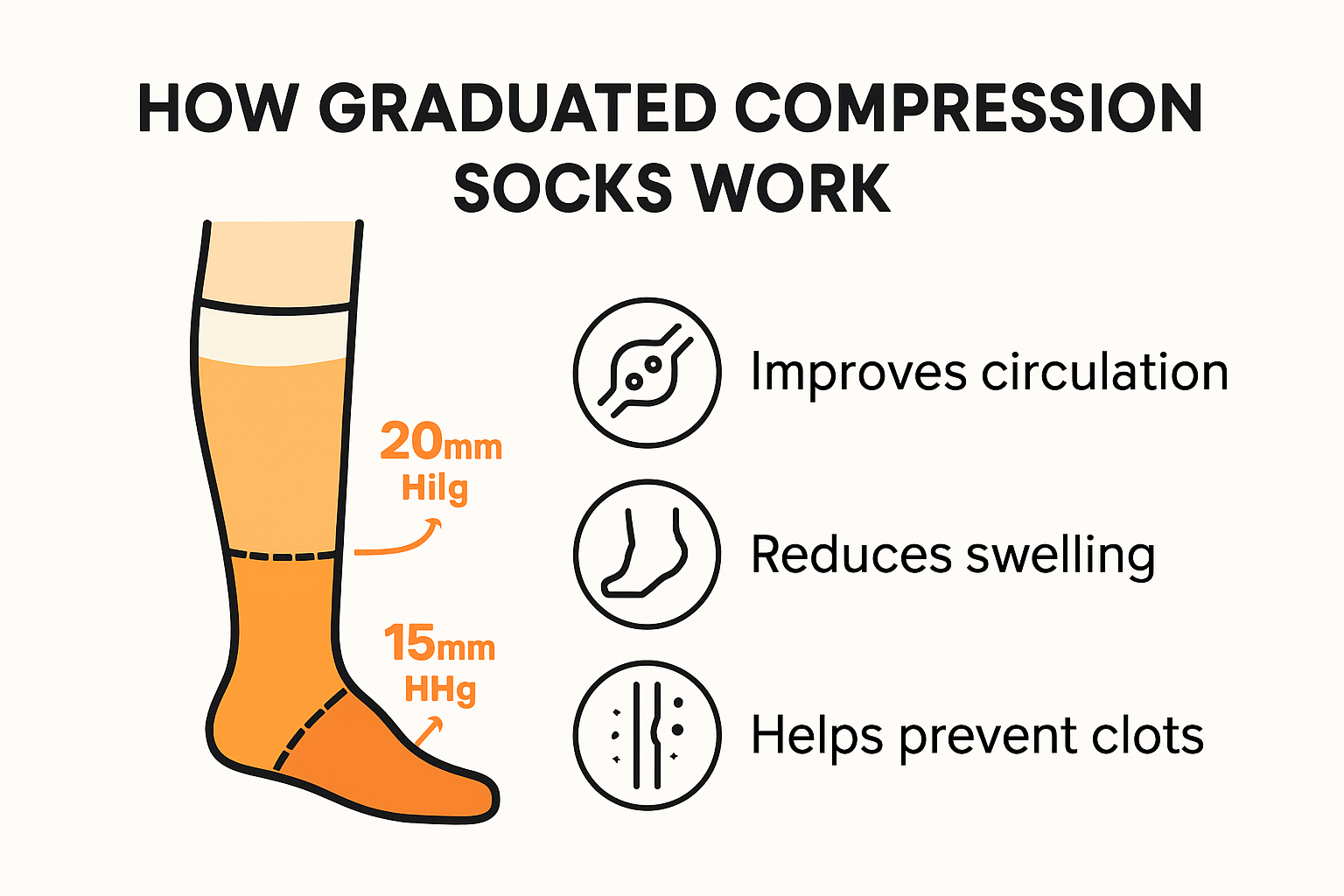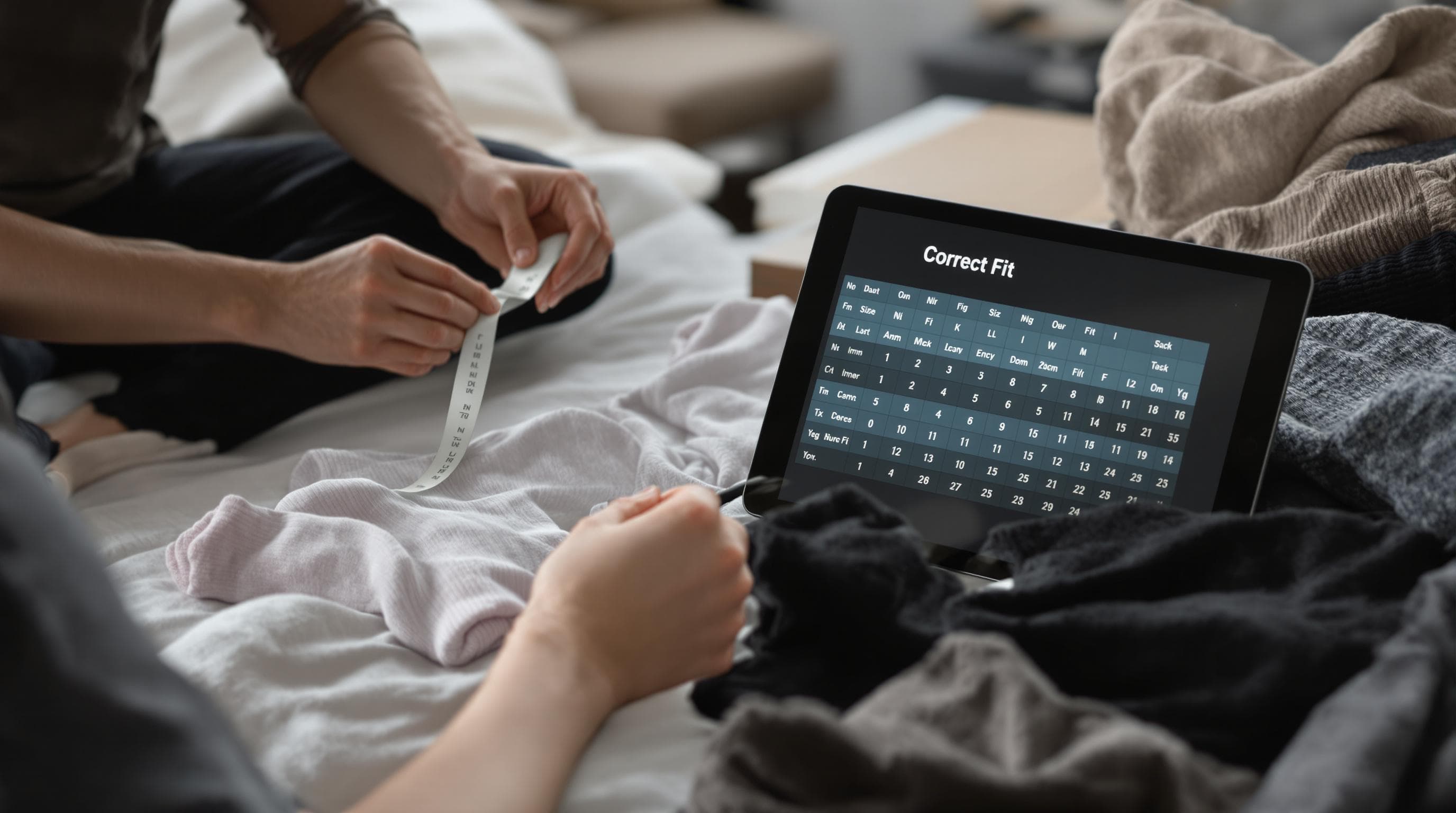
How to Choose Compression Socks: A Helpful Guide for 2025
Share

Compression socks are everywhere these days. You might spot them on marathon runners, nurses on 12-hour shifts, or even travelers stuck on long flights. Most people think they are only for the elderly or recovering patients. But studies show that over 60 million Americans benefit from compression socks each year, and that number keeps growing. The real surprise is that the biggest mistake shoppers make is choosing the wrong compression level—not the wrong style or material.
Table of Contents
- Understanding Compression Socks And Their Benefits
- Key Factors To Consider Before Buying
- How To Pick The Right Compression Level
- Choosing The Best Fit For Your Lifestyle
Quick Summary
| Takeaway | Explanation |
|---|---|
| Understand compression sock benefits. | Compression socks improve circulation, reduce swelling, and support recovery, making them valuable for a wide range of users. |
| Choose the right compression level. | Compression levels from mild to extra firm cater to specific health needs, so consult a healthcare provider for guidance. |
| Ensure proper sizing for effectiveness. | Accurate measurements of ankle and calf size are essential to achieve the right fit and therapeutic benefits. |
| Consider lifestyle and profession needs. | Compression sock choice should align with your daily activities, whether working, traveling, or exercising. |
| Monitor and adjust compression levels as needed. | Regular assessments ensure that your compression therapy remains effective and suited to changes in your health or activity levels. |
Understanding Compression Socks and Their Benefits
Compression socks are specialized medical garments designed to improve circulation and provide therapeutic support for various health conditions. Research from the National Institutes of Health reveals that these strategic garments offer significant physiological benefits beyond typical clothing, making them a critical tool for managing several health challenges.
The Science Behind Compression Technology
Compression socks work through a simple yet powerful mechanism of graduated pressure. Unlike regular socks, they apply strategic pressure from the ankle upward, creating a gradient that helps blood flow more efficiently against gravity. Graduated compression means the pressure is strongest at the ankle and gradually decreases as the sock moves up the leg, which supports natural blood circulation patterns.
The pressure mechanism serves multiple critical functions. It helps prevent blood from pooling in the lower extremities, reduces swelling, and minimizes the risk of blood clots. Medical research published by the American Heart Association confirms that this pressure gradient can significantly reduce the risk of deep vein thrombosis, particularly for individuals with limited mobility or those undertaking long travel.

Who Benefits Most from Compression Socks
Compression socks are not just for patients with existing medical conditions. They serve a broad range of individuals with diverse needs. Key beneficiary groups include:
- Athletes and Fitness Enthusiasts: Improved muscle recovery and reduced post-exercise soreness
- Travelers: Prevention of leg swelling and blood clot risks during long flights
- Healthcare Professionals: Reducing leg fatigue during long shifts of standing
- Pregnant Women: Managing leg swelling and supporting circulatory health
- Individuals with Circulatory Conditions: Managing symptoms of varicose veins and lymphedema
Interested readers can explore our comprehensive guide on compression sock benefits to understand how these remarkable garments can enhance personal health and wellness.
Compression socks represent more than just a medical accessory. They are a proactive approach to supporting your body’s natural circulatory processes, offering comfort, prevention, and potential relief across multiple health scenarios. Understanding their mechanism and potential benefits empowers individuals to make informed decisions about their personal health management.
Key Factors to Consider Before Buying
Choosing the right compression socks involves more than just selecting a comfortable pair. Research from medical professionals emphasizes the importance of careful selection based on individual health needs, pressure gradients, and specific medical conditions.
Understanding Compression Levels
Compression socks are categorized by their pressure levels, measured in millimeters of mercury (mmHg). These levels determine the sock’s therapeutic effectiveness and suitability for different health conditions. Compression levels range from mild to extremely strong:
- Mild Compression (8-15 mmHg): Ideal for everyday wear, light swelling prevention, and minor circulatory support
- Moderate Compression (15-20 mmHg): Recommended for travelers, pregnant women, and individuals with mild leg fatigue
- Firm Compression (20-30 mmHg): Typically prescribed for more significant medical conditions like varicose veins, post-surgical recovery
- Extra Firm Compression (30-40 mmHg): Reserved for severe medical conditions and must be recommended by healthcare professionals
Selecting the wrong compression level can potentially reduce effectiveness or cause discomfort. Medical guidance from vascular specialists suggests consulting a healthcare provider to determine the most appropriate compression level for your specific health requirements.
Material and Comfort Considerations
The fabric composition of compression socks plays a crucial role in their performance and wearability. Different materials offer unique benefits:
- Moisture-Wicking Fabrics: Prevent sweat accumulation and maintain skin comfort
- Breathable Synthetic Blends: Provide flexibility and durability
- Merino Wool Blends: Offer temperature regulation and natural antimicrobial properties
Check out our detailed guide on compression sock benefits to understand how material selection impacts overall performance.
Sizing and Fit Precision
Proper sizing is critical for compression socks to function effectively. An ill-fitting sock can reduce therapeutic benefits and potentially cause circulation issues. Accurate measurement involves:
- Measuring ankle circumference
- Measuring calf width
- Determining the correct sock length (knee-high vs. thigh-high)
- Considering individual body shape and leg dimensions
Most manufacturers provide detailed sizing charts. However, professional measurement by a healthcare provider ensures the most accurate fit. The goal is a sock that provides consistent, graduated pressure without causing discomfort or restricting movement.

Choosing compression socks is a personalized process that requires careful consideration of individual health needs, lifestyle, and physical characteristics. Taking time to understand these key factors ensures you select a compression sock that provides optimal support and comfort.
To help you quickly compare the different compression levels and their recommended uses, here is a summary table:
| Compression Level | Pressure (mmHg) | Typical Users/Scenarios | Example Benefits |
|---|---|---|---|
| Mild Compression | 8-15 | Everyday wear, light swelling, minor fatigue | Prevents minor swelling, supports circulation |
| Moderate Compression | 15-20 | Travelers, pregnant women, mild leg fatigue | Reduces swelling, counters leg discomfort |
| Firm Compression | 20-30 | Varicose veins, post-surgery, lymphedema | Supports recovery, manages medical circulation |
| Extra Firm Compression | 30-40 | Advanced venous disease, severe chronic conditions | Intensive medical management, advanced support |
How to Pick the Right Compression Level
Research from the National Center for Biotechnology Information highlights that selecting the appropriate compression level is crucial for achieving optimal therapeutic benefits. Compression socks are not a one-size-fits-all solution, and understanding the nuanced differences between pressure levels can significantly impact your health outcomes.
Medical Indications for Compression Levels
Each compression level corresponds to specific medical needs and health conditions. Pressure gradients play a critical role in determining the most suitable sock for an individual:
-
Mild Compression (8-15 mmHg): Recommended for preventive care and minimal circulatory support. Ideal for:
- Individuals with minor leg fatigue
- Desk workers experiencing occasional swelling
- Travelers seeking basic circulation support
-
Moderate Compression (15-20 mmHg): A versatile range addressing more specific health concerns. Beneficial for:
- Pregnant women experiencing mild leg swelling
- Individuals with early signs of varicose veins
- Athletes seeking enhanced muscle recovery
-
Firm Compression (20-30 mmHg): Designed for more significant medical interventions. Typically prescribed for:
- Moderate varicose veins
- Post-surgical recovery
- Lymphedema management
- Chronic venous insufficiency
-
Extra Firm Compression (30-40 mmHg): Reserved for severe medical conditions requiring intensive intervention. Used in cases of:
- Advanced venous diseases
- Significant lymphatic disorders
- Severe chronic venous insufficiency
Professional Guidance and Assessment
Selecting the correct compression level requires professional medical assessment. Medical experts recommend a comprehensive evaluation that considers multiple factors:
- Individual medical history
- Current health conditions
- Specific circulatory challenges
- Physical measurements
- Potential risk factors
A healthcare provider can perform precise measurements and recommend the most appropriate compression level tailored to your unique physiological needs. Learn more about personalized compression sock selection to understand the nuanced approach to finding your perfect fit.
Monitoring and Adjusting Compression Levels
Compression needs are not static. They can change based on:
- Pregnancy stages
- Recovery from medical procedures
- Changes in physical activity
- Progression of existing medical conditions
Regular consultations with healthcare professionals ensure that your compression sock strategy remains effective and aligned with your evolving health requirements. Periodic reassessments help optimize the therapeutic benefits and prevent potential complications.
Choosing the right compression level is a precise science that demands careful consideration. By understanding the relationship between pressure gradients and specific health needs, you can make an informed decision that supports your overall circulatory health and wellness.
Choosing the Best Fit for Your Lifestyle
Research from Harvard Health highlights that compression socks are not just a medical accessory but a lifestyle tool adaptable to diverse personal needs. Understanding how different professions, activities, and health conditions influence compression sock selection can help you make an informed choice.
To further clarify how compression sock choice aligns with professional and lifestyle needs, here’s a table summarizing recommendations for different groups:
| User Group | Recommended Compression Level | Primary Goals | Example Activities/Scenarios |
|---|---|---|---|
| Healthcare Professionals | Firm (20-30 mmHg) | Reduce fatigue & swelling | Long shifts standing |
| Office Workers | Mild/Moderate (15-20 mmHg) | Prevent swelling & discomfort | Prolonged sitting |
| Athletes/Fitness | Targeted | Muscle recovery, performance | Running, cycling, weightlifting |
| Travelers | Moderate (15-20 mmHg) | Prevent DVT, reduce swelling | Long flights, road trips |
| Pregnant Women | Moderate (15-20 mmHg) | Manage swelling, support circulation | Pregnancy, post-natal recovery |
| Manual Labor Workers | Higher (as advised) | Support legs during strenuous tasks | Physically demanding jobs |
Profession-Specific Compression Sock Strategies
Your professional environment significantly impacts your compression sock requirements. Different occupations demand unique circulatory support:
- Healthcare Professionals: Long shifts standing require firm compression (20-30 mmHg) to prevent leg fatigue and reduce swelling
- Office Workers: Sedentary roles benefit from mild to moderate compression (15-20 mmHg) to counteract prolonged sitting effects
- Athletes and Fitness Enthusiasts: Need targeted compression for muscle recovery and performance enhancement
- Travelers: Require moderate compression (15-20 mmHg) to prevent deep vein thrombosis during long flights
- Manual Labor Workers: Often need higher compression levels to support legs during physically demanding tasks
Lifestyle and Activity Considerations
The Cleveland Clinic advises that compression socks extend beyond medical necessity. Lifestyle factors play a crucial role in selection:
Athletic Performance
- Runners benefit from graduated compression to improve blood circulation
- Cyclists can use knee-high compression socks for muscle support
- Weightlifters might prefer thicker, more robust compression designs
Travel and Mobility
- Long-distance travelers reduce swelling and clot risks
- Frequent flyers can prevent leg discomfort during extended flights
- Road trip enthusiasts maintain leg circulation during prolonged sitting
Pregnancy and Post-Natal Care
- Pregnant women manage leg swelling and discomfort
- Post-natal recovery support for circulation and muscle recovery
- Reduce risk of varicose veins during hormonal changes
Comfort and Personal Style Alignment
A study in Phlebology emphasizes that comfort and personal style are critical in compression sock selection. Modern compression socks offer:
- Diverse color options
- Multiple fabric choices
- Stylish designs for professional and casual settings
- Moisture-wicking technologies
- Seamless constructions for enhanced comfort
Choosing compression socks is a personalized journey that balances medical necessity, professional requirements, and individual style preferences. By considering your unique lifestyle, you can select compression socks that not only support your health but also complement your daily activities and personal aesthetic.
Frequently Asked Questions
What are compression socks and who benefits from them?
Compression socks are specialized medical garments designed to improve circulation and provide therapeutic support for various health conditions. They benefit athletes, travelers, healthcare professionals, pregnant women, and individuals with circulatory problems.
How do I choose the right compression level for my needs?
Compression socks come in different levels measured in mmHg. Mild compression (8-15 mmHg) is suitable for everyday wear, while higher levels (20-30 mmHg and above) are typically recommended for specific medical conditions. It’s essential to consult a healthcare provider for the appropriate level.
What materials are best for compression socks?
Look for compression socks made from moisture-wicking fabrics, breathable synthetic blends, or merino wool for comfort, durability, and temperature regulation. The material impacts performance and overall wearability.
How do I ensure a proper fit for compression socks?
To ensure proper fit, measure your ankle circumference, calf width, and sock length. Use sizing charts provided by manufacturers and consider seeking professional measurement for the most accurate fit.
Find Your Ideal Compression Socks at Fit Stockings
Choosing the right compression level and style is one of the most important steps for anyone managing circulation concerns, swelling, or fatigue. The article highlights how overwhelming it can be to navigate sizing, materials, and medical needs, especially when a misstep in compression strength can reduce comfort and effectiveness. Most people want support they can trust, whether they’re dealing with varicose veins, recovering after surgery, or staying active during pregnancy.
At Fit Stockings, we make selecting the perfect fit simple. Discover thoughtfully curated options for every need, including trusted brands like Jobst and targeted collections for higher support such as our 30-40 mmHg collection. You will also find a variety of styles and precise sizing guidance designed for results. Visit our main site to see the full range of solutions, or start with our Jobst collection if you are looking for professional quality. Take the first step toward effective compression therapy today and experience greater comfort with every step.
Recommended
- The Ultimate Guide to Compression Stockings: Comfort, Health, and Styl – Fit Stockings
- Compression Stockings and Diabetes: What to Know in 2025 – Fit Stockings
- How to Choose the Right Compression Stockings for Your Needs – Fit Stockings
- The Ultimate Guide to Compression Stockings: What They Are and Who Nee – Fit Stockings

